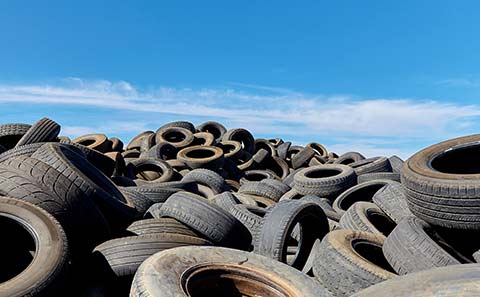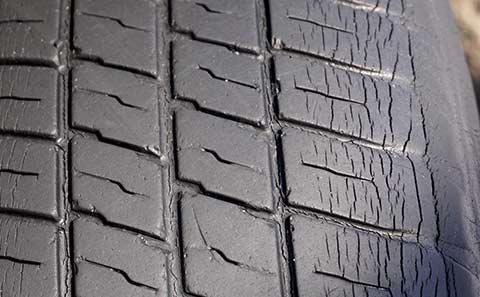As drivers, one of the first things we need to learn about tires is how to read a tire sidewall. Without knowing how tires are measured, we can easily find ourselves in a bind – especially when shopping for our next tire set.
Where to Find Tire Size?
Reading a tire is not a complicated science!
The only problem that can arise is this: consumers do not know what they should get for their vehicles. However, everything you possibly need to know about a tire is mentioned on its sidewall.
Needless to say, different tire sizes will have various numbers, letters, and sometimes even symbols that we have to decipher. But, how can we go about doing this? What are the numbers on a tire and do we know how to read tires correctly?
In this picture, you will see the most important tire codes and symbols located on a tire sidewall:
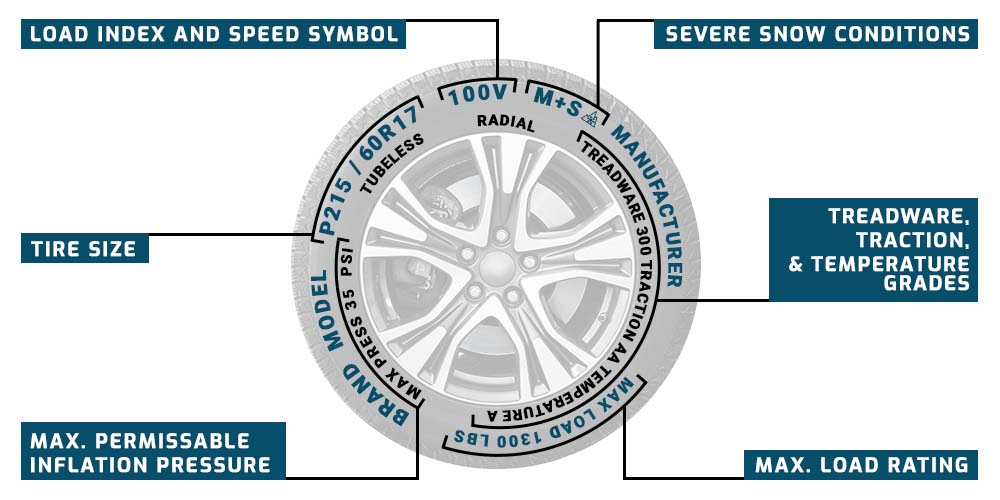
Of course, we will go into more detail for each and every one of these markings.
Understanding Tire Size Codes
Arguably, the most crucial thing is tire sizing. But, learning how to read a tire size on the sidewall is not that complicated. Tires for passenger cars, SUVs, and most light trucks have the same distinction of tire dimensions.
Tire Width (First Number)
The first number on tire size is the tire’s width. It is a three-digit number representing the footprint width in millimeters from one shoulder to the other. In other words, it is the width of the tire’s road contact patch, which also determines the rim width necessary.
Tire Aspect Ratio (Second Number)
The second of the tire numbers indicates the tire’s sidewall height. This is where the tire specification becomes a bit complicated. The tire’s aspect ratio is not a straightforward measurement. Instead, it is the sidewall’s height from the rim to the tread, conveyed as a percentage of the tire’s width.
Rim Diameter (Third Number)
The size of the tires is not complete without the rim diameter. This is the third or last number of the size, explained as the distance measured between the parallel bead seats of a wheel. Yet, it is still important for tires, as this number shows what rim size the tire needs.

What Do the Letters on the Tires Mean?
Reading tire size is not complete without knowing about the numerous letters located on the sidewall and their meaning. If you know how to find the car tire size on the sidewall, you have surely seen that it is an alphanumerical construction.
Apart from the numbers on the sidewall, specific letters also need to be taken into consideration when talking about understanding tire sizes. Let’s see what other marvels the tire’s sidewall contains.
Internal Construction
Have you ever wondered: “What does the “R” mean in tire size?” Well, it indicates the tire’s construction type, along with other symbols. What’s in their structure greatly affects the tire type. The placement of the structural belts will change the tire’s performance and durability.
Radial Tires
Tires with a radial construction will have the letter “R” in their tire size after the aspect ratio. Radial tires feature plies that are placed at 90-degree angles (radially) from one to the other sidewall.
This tire type is most common on modern roads, for a reason. The radial ply placement optimizes the tires for everyday use, as it minimizes the possibility of heat build-up.
Diagonal Tires
Diagonal tires, on the other hand, feature the letter “D” before the wheel diameter. Tires with this construction are made with nylon cord casing layers that are placed diagonally (at 55 degrees) in the tread and sidewall.
Often, diagonal models belong to the trailer category but other tire types are also manufactured with this construction. Passenger car and SUV tires are not available with diagonal constructions, as the primary function of these tires is their load durability.
Bias-Ply Tires
Technically, bias-ply tires are not marked with a letter. Yet, we need to mention them.
Tires with this construction type simply have a hyphen (-) between the aspect ratio and the rim measurements. This indicates that the tire’s internal ply cords are diagonally placed, overlapping each other. They are angled at 30-40 degrees in order to reinforce the tire’s strength.

Load Index and Speed Rating
The next part you need to know about is the tire’s load index and speed rating. These are numbers and letters that are after the tire size. Therefore, if you know how to find the size of your tire, you will be able to easily locate speed ratings and load index as well.
But, what exactly do speed rating and load index mean?
Load Index
The first one is the load index, which determines how much weight one tire can handle. The load index number corresponds to specific lbs the tire withstands while still offering secure performance. Keep in mind that versatile tire types will require different load capacity levels to ensure their safe driving experience.
Speed Rating
After the load index, you will see a letter. This is the letter that indicates the tire’s maximum speed capability. The speed rating letter corresponds to the specific miles/hour (mph) the tire can safely withstand. Be sure to purchase a tire set that can handle the vehicle’s speed capability.

Uniform Tire Quality Grading (UTQG)
Apart from the tire size, there are other tire measurements we need to consider when learning how to read tire codes. One of them is the UTQG rating, which shows the tire’s treadwear, traction, and temperature performance.
This specification is a combination of numbers and letters.
Treadwear Grade
The first one, the treadwear grade, provides a better look into the expected tread life of the specific tire model. For example, if the number is 600, the tire’s excepted tread life is around 60,000 miles. Just keep in mind that external factors greatly influence this.
Traction Rating
The traction rating can be marked with AA, A, B, and C. This represents the tire’s ability to stop on wet road surfaces. The better this rating is (with AA being the best), the shorter its stopping distance will be. Purchasing tires with better traction ratings is always a good idea.
Temperature Grade
Lastly, let’s talk about the temperature grade that indicates the tire’s heat durability. During the vehicle’s performance, heat build-up on the tread area is normal. However, different tires will handle this heat differently. This rating ranges between A, B, and C, showing how well the tires withstand heat.

Severe Snow Conditions and M+S (M/S)
Tire makers calculate the weather durability of their possible models even before they send the products into manufacturing. Therefore, tires are only made if they are able to handle the conditions they were intended for. As a result, all season and winter tires have their own specific markings, which note their performance in such weather conditions.
Tires that feature M+S on their sidewalls are all season models. This indicates their performance in mud and snow, basically rainy and snowy conditions. On the other hand, winter tires hold the 3PMS (three-peak mountain and snowflake) symbol, showcasing the tire’s secure application in freezing and icy situations.

All You Need to Know About Tire Metric Sizing Standards
In a perfect world, every tire type would be on one cohesive tire size chart and manufacturers would just go up and down in numbers to indicate sizes. Sadly, we do not live in that reality.
Tire brands use different ways to mark various tires. “How to read the numbers on a tire?” will have versatile answers depending on what tire type you need to purchase.
Let’s take a look at some of the main tire sizes available on the market.
Reading P-Metric Tires
P-metric tire sizes are manufactured for passenger cars and SUVs. They consist of three sets of numbers and two letters.
The name “P-metric” comes from the first letter (P) that shows the tires are for passenger vehicle applications. Then comes the tire width, aspect ratio, construction type, and rim diameter.
Euro-metric tires are similar, however, they are missing the letter “P” at the beginning.
Euro-Metric Commercial (C-Type) Tires
Euro-metric tires with commercial indications are similar to P-metric tires. They are available in smaller sizes, but their manufacturing reinforced them for better load durability. The only difference is that brands build Euro-metric Commercial tires for commercial applications.
Tire brands will place the letter “C” at the end of the size, portraying this. Commercial tires need specific load capacities to securely perform under larger loads.
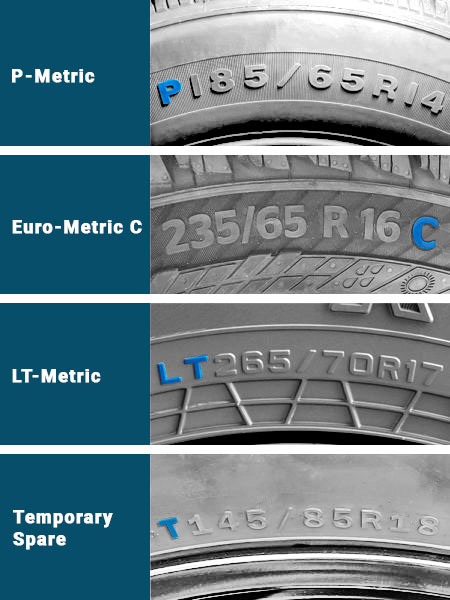
LT-Metric Tires
Bigger vehicles need larger tires, which provide better durability. This is where LT-metric tires come into play. Light truck tire sizes are similar to P-metric tires, there is just two big differences.
Instead of the letter “P”, you will see two letters: “LT”. This literally means the tire is made for light trucks. After this, you will see the rest of a normal tire size, with their measurements.
The other distinction is that light truck tires feature two load indexes. The first one shows how much weight one tire can handle when you mount two tires on an axle, while the second one shows the weight durability of a tire if you use four tires on one axle.
Temporary Spare Tires
Temporary spare tires are smaller than regular tires. Brands usually manufacture them with smaller physical sizes to save on trunk space. However, these tires do not perform as well as normal passenger car tires do.
So, what is a temporary spare tire size? Well, the first letter is “T”, indicating its temporary status. Then comes the width, aspect ratio, construction, and wheel size – just like with regular tires.
Other Tire Sidewall Information
We are still not at the end of our tire guide. There are still a few things we need to discuss.
How to Read the DOT Tire Identification Number?

The tire date coding, or DOT, shows when the tire was manufactured. While the DOT number is a longer number, which provides more information about the tire, its date code portion is the important part.
This is a four-digit number that tells us the week and year of the tire’s manufacture. For example, if the tire’s sidewall states 1020, that means the tire was in production on the 10th week of 2020.
Ply Construction
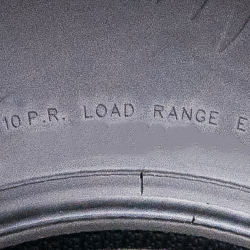
While tires no longer actually feature the number of plies their sidewalls state, the ply rating is still a crucial measurement. Therefore, “How to tell the ply on tires?” is our next section.
Tire brands display the ply rating and load range on the tire’s sidewall. They indicate the load durability of light truck tires. The ply rating shows the ply durability of the tire, in other words, how strong these tires are.
The ply rating is a number, which we count in even numbers starting from 10 for truck tires. However, tire manufacturers also mark passenger tires as well, and they all are 4-ply tires.
On the other hand, the load range is shown with letters, starting from A and going up. The higher this number is, the more load a light truck tire can handle.
Maximum Inflation Pressure and Load Capacity
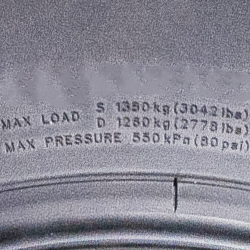
Tire air pressure is important. Not only will proper air pressure levels ensure the tire’s secure performance, but they also secure the tire’s load durability.
Keeping tires at the correct air pressure levels is crucial. But, to do that, you need to know the correct psi levels the tires need. Luckily for us, brands also mark this on the tire’s sidewall under “Max Pressure”.
Above this, “Max Load” indicates the tire’s load durability one more time.
Frequently Asked Questions
What Do the Letters on Tires Mean?
There are different letters available on the tire sidewall. But, the most important letters are part of the tire size. The first one shows whether the tire is P-metric (P) or a light truck size (LT). “R” or “D” shows the tire’s internal structure, as they stand for radial or diagonal.
What Does the 3-digit Number Mean on Tire Size?
The three-digit number is the first number of the standard tire size sequence. This part of the tire size indicates the tire width of P-metric sizes. This shows the exact width of the footprint from shoulder to shoulder in millimeters.
How to Tell What Ply a Tire Is?
With LT-metric tires, you will see a load range stamped on the tire sidewall. Next to this, the tire will state the ply rating of any given light truck tire. However, with P-metric sizes, you will not see this. These tires will only show whether the tire is Extra Load (XL) or Light Load (LL).
